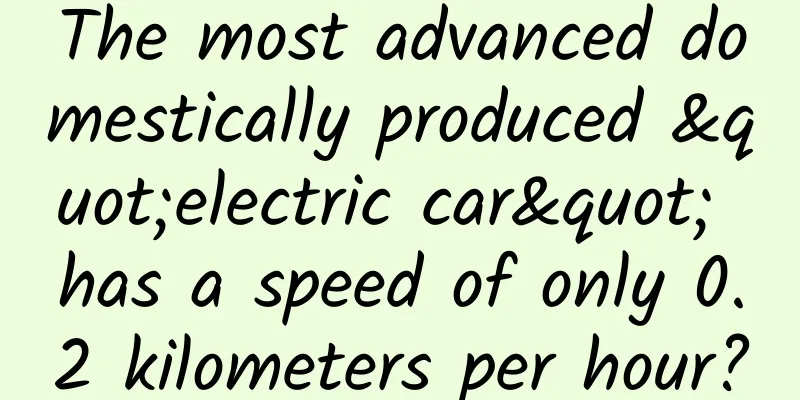The most advanced domestically produced "electric car" has a speed of only 0.2 kilometers per hour?

|
The winning works of the 2023 "China Science Popularization Star Creation Competition" Author: Gao Junwen In the era of traditional fuel vehicles, to increase power, you need to increase the engine displacement. Usually, the larger the displacement, the higher the price of the car, and of course... it is also very fuel-consuming. Nowadays, electric vehicles are developing rapidly. Since electric vehicles have inherent advantages in energy conversion, it has become very simple to increase power. Just equip a high-power motor to bring strong power... Relatively speaking, the electricity bill is also relatively cheap. 380,000 kilometers away from the earth, there is a domestically produced electric vehicle equipped with panoramic cameras, infrared imaging spectrometers, neutral atom detectors and other instruments, but its horsepower is less than 1 horsepower and the design speed is only 0.2 kilometers per hour, which is even slower than ants (ants generally crawl at a speed of 0.5 kilometers per hour). What kind of car is it? It is the electric car driving on the back of the moon - the "Yutu-2" lunar rover. What is a lunar rover? What does it do? Lunar rover, scientifically known as lunar surface patrol probe. On January 3, 2019, Chang'e 4 carrying "Yutu 2" successfully landed on the back of the moon, becoming the world's first lunar rover to operate on the back of the moon. As a satellite that has accompanied the earth for countless days and nights, the moon is the first step for mankind to enter the deep space of the universe, and it is also an arena for various space powers to show their strength. As of September 2023, there are a total of 8 lunar rovers on the moon, including 2 from the former Soviet Union, 3 from the United States, 2 from China, and 1 from India. The lunar rover is actually an "electric car" running on the moon, because its energy and power are almost entirely derived from solar power generation. These "electric cars" have different functions and uses, so their designs are also different. For example, my country's "Yutu-2" is like an intelligent "robot" that can "walk and watch" on the moon and diligently complete its inspection mission; while the US lunar rover is more like a "walking car" on the moon, which astronauts can drive quickly to expand their range of activities. Looking at the lunar rover from the perspective of the "three electrics" of electric vehicles Compared with traditional fuel vehicles, the structure of electric (pure electric) vehicles mainly adds an electric drive control system, cancels the engine, and the battery outputs electricity through the controller to drive the motor to rotate, and the transmission system drives forward or backward. If we want to compare the performance of electric vehicles, the "three electric" parameters must be looked at, namely the motor, battery, and electronic control. The motor of the “three electrics”: power The driving motors of electric vehicles usually have single motors, dual motors, quad motors, etc. In theory, the more motors there are, the better the performance. So far, all lunar rovers on the moon are driven by motors. Over the years, the technology of motors has been relatively mature. Someone will definitely ask, why did the "Yutu-2" only travel 1,455 meters after more than four years of operation, which is less than 1 meter per day? Is it because our motors are not good enough? Of course not. The "Yutu-2" lunar rover uses 6 wheels and 6 motors. The titanium alloy woven mesh wheels are equipped with ratchets, which have certain "off-road" capabilities. In addition, with 4 steering motors, it can turn on the spot and calmly deal with the complex terrain on the lunar surface. In order to overcome the temperature difference of more than 300 degrees between day and night on the lunar surface, the motors are all designed seamlessly to ensure reliability under large temperature differences and effectively prevent lunar dust from entering the motor. As for the "slow" driving speed, the main reasons are as follows: The nature of the task determines the speed The "Yutu-2" went to the moon not for speed racing, but for the specific speed determined by the mission it was to perform. It is worth mentioning that it is the first time to work on the back of the moon, which is an area that humans have never set foot on, and every step must be clearly detected before taking. In addition, when driving, you must pay attention to various craters. There may be hidden stones under the soft lunar soil, and you can't go too fast. From the nature of use, the manned lunar rover of the United States is indeed a mobile means of transportation. For example, the maximum design speed of the Apollo 17 lunar rover is 12 kilometers per hour. The astronauts once "overspeeded" and drove at a speed of 18 kilometers per hour. Energy consumption distribution of the whole vehicle In addition to the vehicle's drive motor, Yutu-2 also carries a large number of instruments and equipment. When the power of the power source (battery) is constant, whether other loads are working will affect the power of the motor, thereby affecting the driving speed of the car, just like when we turn on the air conditioner in the car in summer, the intervention of the compressor will take away part of the engine's power, which will affect the power of the whole vehicle to a certain extent. In addition, in order to ensure the accuracy of the lunar surface detection mission, the lunar rover will stop and go when the equipment is working, which will also affect the overall moving speed. Environmental factors on the moon In addition, the moving speed is also related to the environmental characteristics of the lunar surface. The lunar gravity is low (about one-sixth of that of the Earth) and there is no atmosphere. The Yutu-2 weighs 135 kilograms, making it the lightest lunar rover in history. If the speed is too fast, it may "fly". In addition, the dust on the lunar surface is easily thrown up by the wheels, which may threaten the operation of the entire vehicle equipment, so the speed does not need to be very fast. Batteries (Energy) Today's civilian electric vehicles usually use ternary lithium batteries or lithium iron phosphate batteries. The former has a high energy density and high charging efficiency under the same volume; while the latter has a high number of charging cycles and is more resistant to high temperatures than ternary lithium. The "Yutu-2" is equipped with two types of batteries, one is a solar cell used for daily operation, and the other is a thermal isotope battery that keeps warm at low temperatures. They have different functions and can be converted to each other during the day and night to achieve the power required for operation. Solar Cells The energy of Yutu-2 mainly comes from solar energy. During the day, two solar panels will be unfolded and adjusted by rotating motors. Like a sunflower, it always faces the sun. The solar cells power all the equipment and the rover can start working. But when the moon night comes (the moon rotates and revolves for 27.32 days, half of which is daytime), when it cannot receive solar energy, it needs to put away the solar panels, protect the equipment from low temperatures, and wait for the next day. Therefore, Yutu usually works for half a month and rests for half a month. Isotope battery Due to the huge temperature difference on the moon, the lunar rover has great requirements for batteries. The design of "Yutu-2" fully considered the situation on the moonlit night and carried a piece of black technology - isotope thermoelectric battery based on plutonium 238, also known as "nuclear battery". This substance will continuously emit heat rays during its half-life, and the heat energy released by the isotope will be converted into electrical energy through the thermoelectric converter, providing the probe with no less than 2.5W of electricity on the moonlit night, supporting the operation of the heating equipment, maintaining the internal temperature, and preventing damage caused by low temperature. India's latest lunar rover, the Smart, can travel about 8 meters a day, but its design life is only 14 days, because at the beginning of its design, Indian researchers did not plan to let it spend the night on the moon, and discarded many devices to reduce the difficulty of design and operation. China's Yutu-2 can still work in an extremely low temperature environment, and its actual life has far exceeded its design life, demonstrating its excellent cold resistance and stability. Electronic control of "three electrics": control Many electric vehicles often mention the autonomous driving function (mostly L2 level now) when they are promoted, which means that the vehicle can achieve partial automation (automatic cruising, following the car, braking, etc.) under certain circumstances. The operation is basically completed by the vehicle, and the driver is responsible for peripheral monitoring, but needs to take over the vehicle at any time. A large number of sensors are required to achieve these functions, including cameras, radars, sensors, etc., to collect data about the surrounding environment and control the vehicle after processing by the on-board computer. "Yutu-2" also has many sensors and cameras. When patrolling the lunar surface, it can adopt two modes: ground remote control or autonomous navigation. Ground remote control mode The navigation camera installed on the top is equivalent to the eyes of the lunar rover. It can take pictures and images of the moon and transmit information to the ground through the "Queqiao" relay satellite. After data analysis, researchers determine the specific conditions of the lunar terrain, such as the width and depth of the impact crater, the size and distance of the rocks, and combine the "off-road" capability of "Yutu-2" (20-degree climbing, 20-centimeter obstacle crossing) to plan a safe driving path. Autonomous navigation mode Yutu-2 can also navigate autonomously, mainly through the front-end laser detection and obstacle avoidance camera. The former uses the laser dot array device at the front of the vehicle to project two rows of lasers onto the lunar surface to determine the flatness of the ground ahead; the latter uses the imaging of the obstacle avoidance camera to identify the flatness of the road conditions in sections, and replans every 0.5 meters until it reaches the target point. Conclusion From the arrival of the Yutu rover on the moon to the landing of Yutu-2 on the far side of the moon, China has made significant progress in lunar exploration. As of January 3, 2023, Yutu-2 has traveled 1,455 meters and sent back a large amount of exploration data for us, filling the gap in knowledge about the far side of the moon and deepening our understanding of the formation and evolution of the moon. It has also long become the lunar rover with the longest working time on the moon. Rather than looking back at the past, we prefer to imagine the future. Some time ago, China's manned space program announced the preliminary plan for China's manned lunar landing, planning to land on the moon and conduct scientific exploration before 2030. The moon is likely to be a transit station for humans to land on other celestial bodies. I believe that in the near future, more Chinese spacecraft will fly to deeper space to explore more unknowns and create more Chinese miracles. |
<<: How to use oseltamivir, the "miracle drug" for influenza A, correctly?
>>: New progress in DNA digital storage technology →
Recommend
(How long can the short video industry last) Is there still a future for short videos?
At present, the self-media short video industry i...
Ping An Insurance e-marketing login: What is the difference between Baidu Search Resource Index 3.0 and Baidu Mini Program Index?
In the process of SEO, we often talk about the te...
Apple is also using "hunger marketing" to replace batteries. It has entered "menopause"
On December 9, Apple's vice president of glob...
Dapeng Education - Practical Course in Photo Studio Design Industry Photography Post-production
Dapeng Education - Studio Design Industry Practic...
To users who have difficulty hailing a taxi: Stop cursing. You are actually paying for the new policy.
"The online ride-hailing service has crashed...
AI's sense of smell is far superior to that of humans? Is it a gimmick or a fact? Here comes the truth...
gossip The sense of smell is one of the earliest ...
This is the first time I have seen such a comprehensive information flow optimization case!
After reading this article, you will be able to i...
China Automobile Dealers Association: Used Car Weekly Report from November 8 to 14, 2021
1. Weekly transaction trend of used cars in Novem...
Microsoft pushes Windows 10 Mobile update to non-Insider testers
On Friday, Microsoft pushed Windows 10 Mobile Ins...
30 information flow cases to teach you how to improve conversion
January's creative sharing is finally here! A...
Facing complex road conditions, how does a manned lunar rover master all its skills?
Recently, the design of my country's manned l...
Mushrooms can actually communicate like animals? How do mushrooms "talk"?
Mushrooms are neither animals nor plants, but if ...
A bright star seen in the Southern Hemisphere reveals an ancient collision in the Milky Way
A bright star in the cluster, visible from the So...
Yan Hu's Mandala Painting Theory + Practical Painting Psychology Video Course 26 Lectures on Emotional Regulation and Self-Growth
Yan Hu's Mandala Painting Theory + Practical ...
"Jiquan Direct Current" tells you how Xinjiang's electricity lights up China's nights!
Recently, good news came from the west of the mot...









